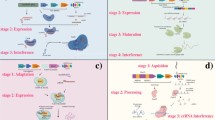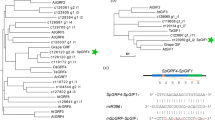Abstract
A mutation in the maize Ms45 gene results in abortion of microspore development and a male-sterile phenotype. MS45 protein has been localized to the tapetum and maximally expressed in anthers at the early vacuolate stage of microspore development. Molecular complementation analysis determined that a transformed copy of the gene fully restored fertility to ms45 maize. In this report, using phenotypic complementation as an assay, chimeric transcriptional activators were expressed to regulate a gal:MS45 gene and test the ability of a multi-component system to restore male fertility. A high frequency of phenotypic complementation was observed when either C1-GAL4 or VP16-GAL4 activators were transcribed by promoters that expressed at a stage of anther development that precedes the early vacuolate stage of microsporogenesis. For the conditional regulation of male fertility, these transcriptional activators were modified by the addition of regions that include the ligand-binding domain from the European corn borer ecdysone receptor to generate the nuclear receptors C1-GAL4-EcR (CGEcR) and VP16-GAL4-EcR (VGEcR). These chimeric receptors were introduced with the gal:MS45 gene into ms45 maize, and in the absence of ligand, these plants were male sterile. In contrast, application of the ecdysone agonist, methoxyfenozide, to plants containing either a constitutive (Ubiquitin1) or anther-specific (maize 5126) VGEcR resulted in the restoration of fertility to ms45 plants grown in either the greenhouse or in the field.
Similar content being viewed by others
References
Albertsen MC, Brooke CD, Garnaat CW and Roth BA (2000) Ecdysone receptors and methods for their use. International Patent Application WO 00/15791.
Albertsen MC, Fox TW and Trimnell MR (1993) Cloning and utilizing a maize nuclear male sterility gene. Proc Ann Corn Sorghum Res Conf 48: 224–233.
An G, Mitra A, Choi HK, Costa MA, An K, Thornburg RW et al. (1989) Functional analysis of the 3 control region of the potato wound-inducible proteinase inhibitor II gene. Plant Cell 1: 115–122.
Aoyama T and Chua N-H (1997) A glucocorticoid-mediated transcriptional induction system in transgenic plants. Plant J 11: 605–612.
Bram RJ and Kornberg RD (1985) Specific protein binding to far upstream activating sequences in polymerase II promoters. Proc Natl Acad Sci USA 82: 43–47.
Bruce W, Folkerts O, Garnaat C, Crasta O, Roth B and Bowen B (2000) Expression profiling of the maize flavonoid pathway genes controlled by estradiol-inducible transcription factors CRC and P. Plant Cell 12: 65–80.
Caddick MX, Greenland AJ, Jepson I, Krause KP, Qu N, Riddell KV et al. (1998) An ethanol inducible gene switch for plants used to manipulate carbon metabolism. Nat Biotechnol 16: 177–180.
Carey M, Kakidani H, Leatherwood J, Mostashari F and Ptashne M (1989) An amino-terminal fragment of GAL4 binds DNA as a dimer. J Mol Biol 209: 423–432.
Christensen AH, Sharrock RA and Quail PH (1992) Maize poly-ubiquitin genes: structure, thermal perturbation of expression and transcript splicing, and promoter activity following transfer to protoplasts by electroporation. Plant Mol Biol 18: 675–689.
Christopherson KS, Mark MR, Bajaj V and Godowski PJ (1992) Ecdysteroid-dependent regulation of genes in mammalian cells by a Drosophila ecdysone receptor and chimeric transactivators. Proc Natl Acad Sci U S A 89: 6314–6318.
Cigan AM, Unger E, Xu R-J, Kendall TL and Fox TW (2001) Phenotypic complementation of ms45 mutant maize requires tapetal expression of the Ms45 gene. Sex Plant Reprod. 14(3): 135–142.
De Veylder L, Van Montagu M and Inze D (1997) Herbicide safener-inducible gene expression in Arabidopsis thaliana. Plant Cell Physiol 38: 568–577.
Dhadialla TS, Carlson GR and Le DP (1998) New insecticides with ecdysteroidal and juvenile hormone activity. Annu Rev Entomol 43: 545–569.
Evans RM (1988) The steroid and thyroid hormone receptor super-family. Science 240: 889–895.
Gatz C (1997) Chemical control of gene expression. Annu Rev Plant Physiol Plant Mol Biol 48: 89–108.
Gatz C, Frohberg C and Wendenburg R (1992) Stringent repression and homogeneous de-repression by tetracycline of a modified-CaMV 35S promoter in intact transgenic tobacco plants. Plant J 2: 397–404.
Goff SA, Cone KC and Fromm ME (1991) Identification of functional domains in the maize transcriptional activator C1: comparison of wild-type and dominant inhibitor proteins. Genes Dev 5: 298–309.
Greenland A, Bell P, Hart C, Jepson I, Nevshemal T, Register III J et al. (1997) Reversible male-sterility: a novel system for the production of hybrid corn. In: Greenland AJ, Meyerowitz EM and Steers M (eds), Control of Plant Development: Genes and Signals. (pp. 141–147) Company of Biologists Ltd., Cambridge, UK.
Guyer D, Tuttle A, Rouse S, Volrath S, Johnson M, Potter S et al. (1998) Activation of latent transgenes in Arabidopsis using a hybrid transcription factor. Genetics 149: 633–639.
Hoppe UC, Marban E and Johns DC (2000) Adenovirus-mediated inducible gene expression in vivo by a hybrid ecdysone receptor. Mol Ther 1: 59–164.
Jepson I, Lay VJ, Holt DC, Bright SW and Greenland AJ (1994) Cloning and characterization of maize herbicide safener-induced cDNAs encoding subunits of glutathione S-transferase isoforms I, II and IV. Plant Mol Biol 26: 1855–1866.
Keegan L, Gill G and Ptashne M (1986) Separation of DNA binding from the transcription-activating function of a eukaryotic regulatory protein. Science 231: 699–704.
Kothapalli R, Palli SR, Ladd TR, Sohi SS, Cress D, Dhadialla TS et al. (1995) Cloning and developmental expression of the ecdysone receptor gene from the spruce budworm, Choris-toneura fumiferana. Dev Genet 17: 319–330.
Laughon A and Gesteland RF (1984) Primary structure of the Saccharomyces cerevisiae GAL4 gene. Mol Cell Bio 4: 260–267.
Lloyd AM, Schena M, Walbot V and Davis RW (1994) Epidermal cell fate determination in Arabidopsis: patterns defined by a steroid-inducible regulator. Science 266: 436–439.
Ma J and Hu J (1988) Yeast activators stimulate plant gene expression. Nature 334: 631–633.
Martinez A and Jepson I (1999) Ecdysteroid agonist-inducible control of gene expression in plants. In: Reynolds PHS (ed.), Inducible Gene Expression in Plants. (pp. 23–41) CAB International Publishing Wallingford, Oxfordshire.
Martinez A, Sparks C, Drayton P, Thompson J, Greenland A and Jepson I (1999a) Creation of ecdysone receptor chimeras in plants for controlled regulation of gene expression. Mol Gen Genet 261: 546–552.
Martinez A, Sparks C, Hart CA, Thompson J and Jepson I (1999b) Ecdysone agonist inducible transcription in transgenic tobacco plants. Plant J 19: 97–106.
McKenzie MJ, Mett VV, Reynolds SPH and Jameson PE (1998) Controlled cytokinin production in transgenic tobacco using a copper-inducible promoter. Plant Physiol 116: 969–977.
Mett VL, Lochhead LP and Reynolds PH (1993) Copper-controllable gene expression system for whole plants. Proc Natl Acad Sci USA 90: 4567–4571.
Neuffer MG, Coe EH and Wessler SR (1997) Mutants of Maize. Cold Spring Harbor Laboratory Press, Plainview, NY.
No D, Yao TP and Evans RM (1996) Ecdysone-inducible gene expression in mammalian cells and transgenic mice. Proc Natl Acad Sci USA 93: 3346–3351.
Paz-Ares J, Ghosal D, Wienand U, Peterson PA and Saedler H (1987) The regulatory c1 locus of Zea mays encodes a protein with homology to myb proto-oncogene products and with structural similarities to transcriptional activators. EMBO J 6: 3553–3558.
Schena M, Lloyd AM and Davis RW (1991) A steroid-inducible gene expression system for plant cells. Proc Natl Acad Sci USA 88: 10421–10425.
Severin K and Schoeffl F (1990) Heat-inducible hygromycin resistance in transgenic tobacco. Plant Mol Biol 15: 827–833.
Suehara K-I, Takao S, Nakamura K, Uozumi N and Kobayashi T (1996) Optimal expression of GUS gene from methyl jasmonate-inducible promoter in high density culture of transformed to-bacco cell line BY-2. J Ferm Bioeng 82: 51–55.
Triezenberg SJ, Kingsbury RC and McKnight SL (1988) Functional dissection of VP16, the transactivator of herpes sim-plex virus immediate early gene expression. Genes Dev 2: 718–729.
Tsai M-J and O'Malley BW (1991). Mechanisms of regulation of gene transcription by steroid receptors. In: Cohen P and Foulkes JG (eds), The hormonal Control Regulation of Gene Transcription. (pp. 101–116) Elsevier Science Amsterdam.
Unger E, Betz S, Xu R-J and Cigan AM (2001) Selection and orientation of adjacent genes influences DAM-mediated male sterility in transformed maize. Transgenic Res 10: 409–422.
Unger E, Parsons RL, Schmidt RJ, Bowen B and Roth BA (1993) Dominant negative mutants of opaque2 suppress transactivation of a 22-kD zein promoter by opaque2 in maize endosperm cells. Plant Cell 5: 831–841.
Walker D, Htun H and Hager GL (1999) Using inducible vectors to study intracellular trafficking of GFP-tagged steroid/nuclear receptors in living cells. Methods 19: 386–393.
Wilde RJ, Shufflebottom D, Cooke S, Jasinska I, Merryweather A, Beri R et al. (1992) Control of gene expression in tobacco cells using a bacterial operator-repressor system. EMBO J 11: 1251–1259.
Zuo J and Chua N-H (2000) Chemical-inducible systems for regulated expression of plant genes. Curr Opin Biotechnol 11: 146–151.
Zuo J, Niu QW and Chua NH (2000) An estrogen receptor-based transactivator XVE mediates highly inducible gene expression in transgenic plants. Plant J 24: 265–273.
Author information
Authors and Affiliations
Corresponding author
Rights and permissions
About this article
Cite this article
Unger, E., Cigan, A.M., Trimnell, M. et al. A Chimeric Ecdysone Receptor Facilitates Methoxyfenozide-Dependent Restoration of Male Fertility in ms45 Maize. Transgenic Res 11, 455–465 (2002). https://doi.org/10.1023/A:1020350208095
Issue Date:
DOI: https://doi.org/10.1023/A:1020350208095




